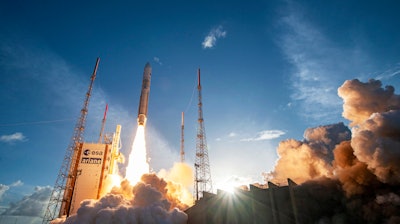
BERLIN (AP) — The European Space Agency said Friday that an investigation into the failure of a rocket carrying two Earth observation satellites last year indicated the cause was a faulty part procured from Ukraine.
The Vega C rocket ditched in the sea less than three minutes after liftoff from a spaceport in French Guiana in December. Arianespace, which provided the launch service, said at the time that decrease in pressure was observed in the rocket's second stage, "leading to the premature end of the mission."
"The cause of the failure was a gradual deterioration of the Zefiro 40's nozzle," the European Space Agency said.
The Zefiro 40 second stage, made by Italian space company Avio, suffered "an unexpected thermo-mechanical over-erosion" of a carbon component procured in Ukraine, it said.
Pierre-Yves Tissier of Arianespace said the conclusion was based on an examination of identical parts and still needed to be confirmed through further tests.
ESA added that during the inquiry "no weakness in the design of Zefiro 40 has been revealed."
The launch was the third failure in the past eight launches of Vega and Vega C rockets, an embarrassment for the agency and its partners.
"We will overcome this very difficult moment," Arianespace head Stephane Israel told reporters.
ESA chief Josef Aschbacher added that measures would now be implemented "to get out of this crisis stronger."
The launch was meant to take two Earth observation satellites made by Airbus, Pleiades Neo 5 and 6, into orbit. The satellites would have been part of a constellation capable of taking images of any point on the globe with a resolution of 30 centimeters (12 inches).






















